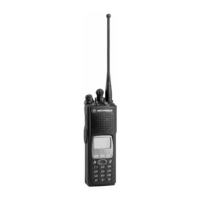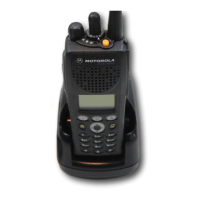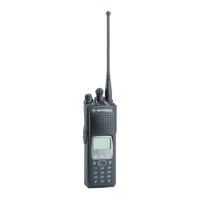6881094C28-D July 16, 2004
Disassembly/Reassembly Procedures: Ensuring Radio Submergibility 8-19
8.10.8 Pressure Test
Pressure testing the radio is necessary only if the radio has failed the vacuum test. Do not perform
the pressure test until the vacuum test has been completed. Pressure testing involves creating a
positive pressure condition inside the radio, submerging the radio in water, and observing the radio
for a stream of bubbles (leak). Since all areas of the radio are being checked, observe the entire unit
carefully for the possibility of multiple leaks before completing this test.
NOTE: Refer to the exploded view diagrams and parts lists found in “Chapter 10: Exploded Views
and Parts Lists” on page 10-1.
To conduct the pressure test:
1. Remove the vacuum test port using a pair of needle-nosed pliers and pulling upward.
2. Screw the adapter (with gasket) into the tapped hole in the casting.
3. Attach one end of the pressure hose to the adapter and the other end to the pressure pump.
4. Cover the vent port seal (61) and label (62) on the back of the casting with your thumb. This
will prevent air from going through the seal. Keep the vent port covered with your thumb until
the test is complete (through step 8).
5. Operate the pump until the gauge reads approximately 1 psig.
6. Maintain the pressure at 1 psig and submerge the radio into a water-filled container. Keep the
vent port covered with your thumb while the radio is submerged.
7. Watch for any continuous series of bubbles. A stream of bubbles indicates a sign of leakage.
NOTE: Some air entrapment may cause the accumulation of bubbles, especially in the
grille area, but the bubbles should not be continuous.
8. Note all of the seal areas that show signs of leakage. Pinpoint the problem(s) to one (or more)
of the following areas:
-Housing
- Antenna bushing seal
- Controls seal
- Frequency switch, toggle, and on/off/volume control switch
- Main seal
- Battery contact and battery contact seal
-Keypad
9. Remove the radio from the water container, remove your thumb from the vent port seal, and
dry the radio thoroughly. Be especially careful to dry the area around the main seal to prevent
contamination of the internal electronics while the unit is open.
Pressure any greater than 1 psig might push air around the
main seal.
!
a u t i o

